
Creative Ways to Display Photos
When you really think about it, what makes your house your home? Sure, you own it, you live in it, and all your stuff is there. But if a stranger were to walk in, how would they know who lived there and what their story is? For many of us, it’s the pictures. Adorning the living room walls, hung by magnets on the refrigerator door, or propped up on the coffee table next to the bed, pictures tell our stories and capture our most precious memories.
More than just decorations, these cherished memories deserve to be displayed in the best light (no pun intended) as possible. That’s why we’ve gathered talented photographers from Sacramento to New York to offer their thoughts on the most creative ways to display photos in your home, often using their own work as an example. Read on and enjoy this unique collection of work and creative tips from gifted shutterbugs across the country!
Consider the colors and lighting
Print technology has evolved significantly over the last 5 years. Professional specialty labs that work with photographers are now capable of reproducing the capabilities of modern extreme high-resolution cameras, when used by a professional, to deliver an enormous amount of details and dynamic range. We have entered the realm of Ultra High Definition prints, and the ultimate presentation, in my opinion, is an Ultra HD print under Acrylic Glass. This is a Frameless print format. When it comes to detail, color saturation, UV light resistance and lifelike realism the Acrylic print format has no peer. The acrylic glass captures ambient light and provides an almost 3D effect. This is a premium quality photographic display that delivers opulence and will last a lifetime! – Thomas Schoeller Photography
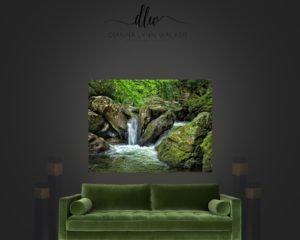
For a sophisticated and elegant look in displaying your photographic art, I have always turned my attention to the space that I am working with, in this case, a room that has a modern vibe for hosting guests. If you want your art to pop, paint your wall or walls a deeper neutral gray or charcoal color. Keep it simple. What piece of photographic art wouldn’t stand out for that striking, contemporary look? – Dianna Lynn Walker Fine Art

Your walls are a blank canvas, and filling them with special memories from your life is the best way to make your home feel a happy place. Don’t forget to set your style right in the beginning. If you like things clean and modern, monochromatic black & white photos will do the magic. If you’re more of an eclectic person, mix it up – go with different types of frames, vintage versus recent photos, but most importantly let your photo wall be a reflection of the people who live there. – Localgrapher
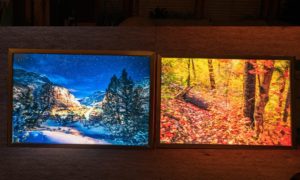
For a striking and creative way to display photography, consider using a lightbox. Photos are printed on Duratrans film, which is translucent and lighted from behind with LEDs. Bold subjects with strong contrast and light work best. The assembled lightbox can be displayed either hanging on a wall or resting on a hard flat surface such as a table. – Stan Rose Images
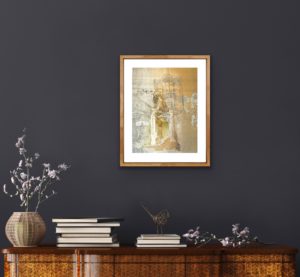
When displaying photos in your home it is important to balance two things: the overall color scheme and décor of your rooms and your personal connection to the images. Express your taste in a way that is unique to your memories, travels and personal story. Black and white photos are in some ways the easiest to work with, as they are compatible with so many contemporary color schemes. Black and white photos stand out by contrast on brilliantly colored walls and work through harmony in surroundings of neutral beige and gray. Toned photographs must be carefully coordinated with the colors around them so the furnishings and room feel like a unified whole. To avoid the distractions of glass you can have photographic prints mounted on archival backing, sprayed with UV protection and floated in a frame, as shown here. Keeping a white border is a matter of taste – but it tends to set off the image and minimize tonal clashes with surrounding colors. – Iskra Fine Art
- For framed prints, I pay attention to the glass—it’s better to invest in a non-glare glass if you’re home has many sunny windows. It’s worth it to see those beautiful family or wedding photos! 2. I definitely recommend mockups for wall art. So many people think an 11×14 is big, and it’s really not unless you are grouping it with other images. 3. In my own home, my preference is to hang images of beautiful Colorado landscapes with my family taking up a small space in the image in high traffic areas. Close-up portraits of us are reserved for bedrooms. – Susannah Photo
Photo tip: For a chic yet classic look, consider using floating framed canvases. Add dropped lighting to display the artwork and consider using the same colored floating frame across all pieces of artwork for a uniformed look / tone / feel. – Mary’s Mark
Location, location, location
Protect your precious photographs from fading. As a fine art photographer, I’m very concerned with the longevity of my work — I want it to last for generations. Lab studies have shown that modern inkjet prints (pigment-based, not dye-based) can last hundreds of years when properly framed and displayed. To keep your valuable family portraits or fine art prints looking good, be sure they’re behind UV protective glass, and avoid displaying them in direct sunlight or under UV-emitting light bulbs. Professional framing can also protect your prints from dust and insect damage. – Keith Dotson Photography

The visual impact of these pieces is breathtaking; the exceptional definition gives the viewer an immediacy, as if they’re stepping into the landscape. An entranceway of many clients’ homes gives the impact they deserve for the powerful large pieces, especially the mountains shot from a helicopter. From Living, Formal Dining areas, Home Office to Bedroom spaces, these pieces give a feeling of peace and tranquility with the wow factor. – Romer Gallery
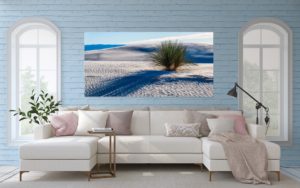
In addition to selecting a photo with colors and tones that compliment the room, choosing the correct size of the print is extremely important. A great tip is to determine an estimate of the size of the print that you think will work and then use blue painters tape to mark the outline of those dimensions on the wall. Pay attention to the height (not too high) so that the eye naturally flows to the subject in the photo. Take several steps back to get a good look at the entire room – how the dimensions of the image fit – and don’t be surprised if you determine that a larger size is needed. – Michael Ryno Photography
With over a decade of experience in installing fine art photography into customer’s homes, one thing really stands out: size matters. Having a single large and well-framed piece in a room really makes a powerful statement. A stunning 6-foot long panorama fits perfectly in so many spaces, such as over the sofa in the living room, along that giant wall in the dining area, or over a king-size bed. While high-gloss metal prints are all the craze these days, keep in mind that reflections are a real issue. My best-selling print surface has a lower glare and is a true pigment print with a UV protective coating, when people get this into their homes they are always satisfied and glad that they can’t see the reflections of all the windows across the room. – Alex Burke Photography
Complement your picture with the perfect frame, or go frameless
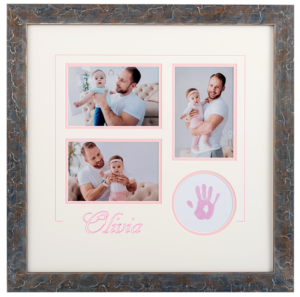
Displaying professionally framed photos in your home is a great way to preserve and share memories of your family’s special times together. The Great Frame Up can assist you in selecting a variety of coordinating mat borders and frames that not only complement the photographs but complement your home’s décor, ensuring a cohesive look while avoiding the appearance that you purchased off-the-shelf frames en masse. Photos from a special vacation or event can be framed similarly and hung adjacent to one another or they can be presented in a multi-opening mat in a single frame. Hanging the photos in foyers or family rooms allows both your family and guests to enjoy them and, whatever the lighting conditions may be, anti-reflective Museum Glass allows you to see every detail clearly. – The Great Frame Up
A popular place many people are designing their photo wall is around their staircases. A photo wall display easily livens up a usually boring staircase and is the perfect area to place smaller wall frames. As you walk up or down the steps, you can arrange the wall frames to gradually age for a nice effect. You want to use a similar style of frames, for example, you don’t want to mix metal frames and wood picture frames just like you wouldn’t want to mix a modern style of frame with an ornate picture frame. – Frame USA
Frames come in many designs, colors, and materials. Choose a design that would compliment and not overpower the item. Also consider matching the frame with your furniture, for harmony in the room. And don’t feel limited to using a single frame; you could use multiple frames to add drama to your subject. Art framing is diverse – feel free to think outside the box! – Cadillac Art & Frame

A lot of people prefer to stick with the simple black frames for their photography, but I prefer to use more interesting frames – metallic, silver, white, a colored lacquer. I love mixing them together in different sizes and shapes to create a complex feeling on a wall. And one of my favorite things is to use a large corkboard that I can tack my current favorite photos on, and change constantly. – James Maher Photography
 Canvas prints are my favorite way to display photos without frames. The photo is printed on to canvas, then stretched over a frame similar to a painting, which gives fine art quality to your photos. Portraits and landscapes work especially well as a canvas print, but almost any photo can work – use your creativity! Create a 40” x 26” multi-panel wall display of your family with one family portrait, and two smaller prints of the kids or use pictures from your favorite vacation. – PhotographySpark
Canvas prints are my favorite way to display photos without frames. The photo is printed on to canvas, then stretched over a frame similar to a painting, which gives fine art quality to your photos. Portraits and landscapes work especially well as a canvas print, but almost any photo can work – use your creativity! Create a 40” x 26” multi-panel wall display of your family with one family portrait, and two smaller prints of the kids or use pictures from your favorite vacation. – PhotographySpark
Tell a story using a photo wall
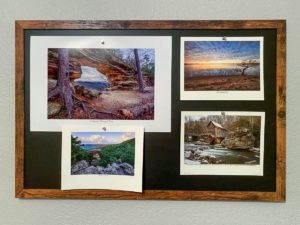
Without the luxury of infinite wall space, most people are very particular about the photos they chose to display in their homes. As a landscape photographer, I prefer to arrange and examine an assortment of images at my leisure. A decorative magnetic chalkboard provides the perfect frame to display your favorite photos in any manner imaginable. – ScottymanPhoto

Photo walls are really fashionable: they’re in all the interior design magazines! For this kind of display, you need to take care with the composition, especially if the photos chosen don’t have the same format or orientation (portrait or landscape). We suggest you start by doing some sketches to test out different arrangements. First, put in the biggest photo, then arrange the others around it, trying to create a sense of dialogue between them (if you’re working with portraits, have the subjects looking at each other. Where images don’t have a particular theme, look to match up shapes or colors). If you want a spontaneous and bohemian feel, avoid compositions that are too square or rectangular. Instead, try to create the impression of movement by introducing asymmetry. For example, this display of black and white photographs by German artist Klaus Kampert is arranged around a clear vertical line created by lining up 4 photos in light shades, while the darkest images are at the outsides. – Artistics

Miami skyline at sunset
When creating a family photo wall it is important to have an overall design in mind prior to the start of affixing photos to your wall. A unique way to display your family photos, and to tell a story at the same time, is to place your family portrait in the middle of the wall. From there you place photos that are older around the family photo in a circular fashion and work your way out to your latest family photos. This way people can start in the center and as the move away from the center of the wall they can see the growth and changes in your family over time. When you think of a family tree you think of roots and roots branch out over time, just like the way you have placed the photos on your wall. – JC Ruiz Photography

Capturing the essence of a single moment – photographs turn a house into a home and are cherished for a lifetime. Having the same photographer throughout the years helps make this task very easy. Find a central wall in your home to arrange the frames. Choose photos that tell a story or remind you of special memories and hang them in a pattern that compliments your room. – Photography G



